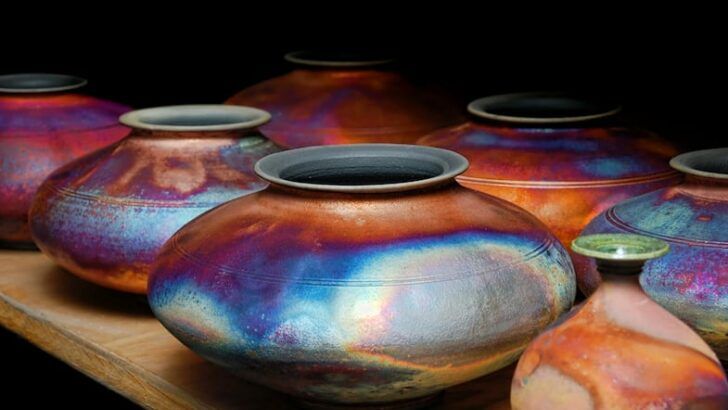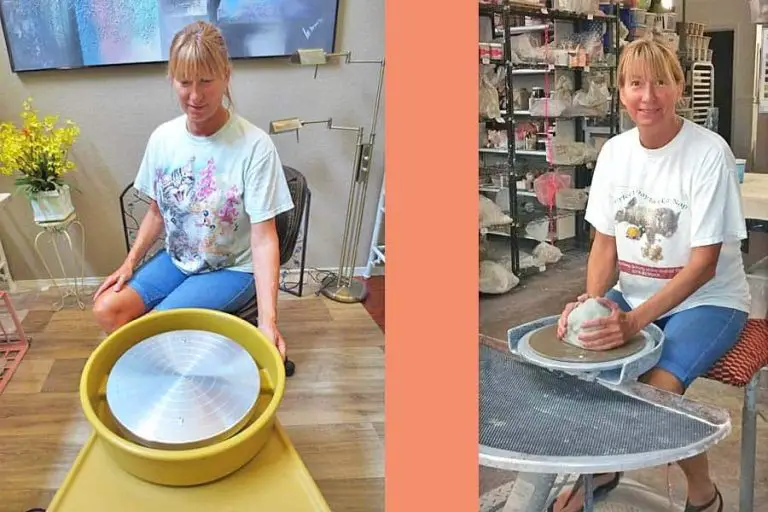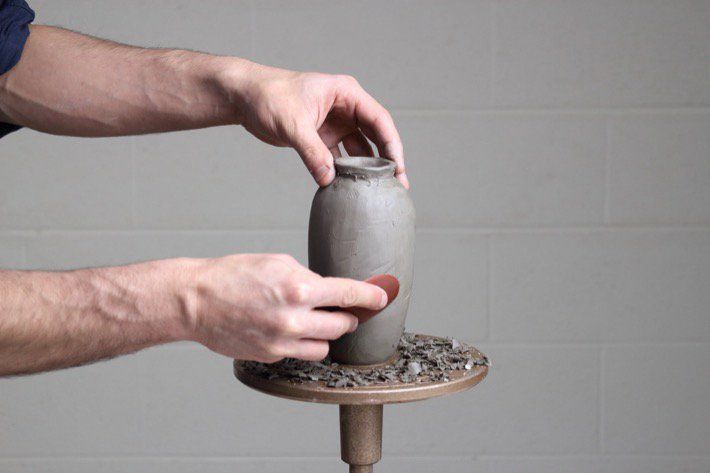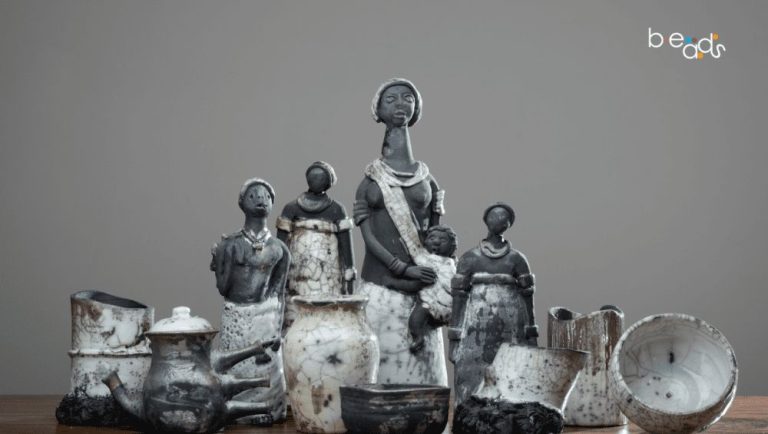What Is The Nerikomi Method?
Nerikomi is a Japanese term that refers to a marbling technique used in ceramic art. It involves stacking and cutting different colored clays to create patterns and designs when the clay slab is assembled.
Although Nerikomi is a Japanese term, the technique actually originated in Ancient Egypt as a marbling technique according to this source. Over time, it spread to Rome, England and China. The technique was brought over to Japan in the mid-19th century.
The materials used in Nerikomi are colored porcelain or stoneware clays. The colors are mixed into the clay body rather than applied as surface decoration. The clays can be used alone or blended together to create patterns when assembled.
Making Nerikomi Slabs
The first step in creating nerikomi pottery is making the colored clay slabs that will be used to assemble the pattern. This involves rolling out and cutting blocks of differently colored clay to the same thickness. Consistency in the slab thickness is crucial for getting clean lines and a crisp pattern in the final piece.
To make the slabs:
– Knead and wedge each color of clay thoroughly until it is smooth and free of air bubbles. This ensures an even consistency when rolling.
– Roll out each color using a rolling pin or slab roller to the desired thickness, usually 1/4″ or less. Check for consistency with a ruler.
– Cut the clay into square or rectangular blocks using a tissue blade or clay cutter. Slice down smoothly and vertically to get straight edges.
– Keep the slabs layered between parchment paper so they don’t dry out before assembly. Store any excess for later use.
Taking care in rolling, cutting, and storing the clay slabs is the foundation for creating clean nerikomi patterns. Consistency in slab thickness and using sharp cutting tools will result in blocks that fit together precisely.
Source: https://thepotterywheel.com/nerikomi-pottery/
Assembling the Pattern
Once the differently colored clay slabs have been created, it’s time to assemble them into the final nerikomi pattern. Planning out the design in advance is important to achieve the desired effect. Sketching out ideas on paper first can be helpful.
The basic technique involves alternating layers of contrasting colored slabs and carefully joining them together. Start by rolling out the base slab to the desired thickness. Place the next color slab on top, aligning the edges neatly. Use water to help the layers adhere to each other. Continue stacking and alternating colors until the full pattern is built up.
Take care when joining the slabs to avoid trapping air bubbles between the layers. Gently press out any air pockets that appear or cut into the clay to release trapped air. Smoothing the seams ensures the layers bind together cleanly with no gaps.
The pattern can be extended outwards by adding more layers to the sides. Allow the assembled clay packet to dry slightly before carving into shapes or sculpting as desired. The nerikomi design will be revealed as slices are cut into the finished piece.
Additional Techniques
Nerikomi artists have developed many additional techniques beyond the basic slab construction method to create more intricate and visually interesting patterns (Creating Nerikomi Blocks: Decorating with Colored Clay Patterns). Some common techniques include:
Using scraps of colored clay left over from other projects is an easy way to add more color variation without having to wedging a lot of new clay. Just roll the scraps into thin sheets and incorporate them into the slab layers. This is a great way to use up leftover clay.
Combining nerikomi with wheel throwing opens up many possibilities. Throwing nerikomi patterned cylinders to use as vessel bodies allows asymmetry and flowing lines not possible with slab construction. Sections of patterned nerikomi slabs can also be applied to wheel thrown forms as decorative elements.
Adding textures through techniques like carving, pressing molds, or rolling over texture sheets before assembling the nerikomi slab gives even more visual interest. Different textures on each layer of the slab creates patterns when the layers are revealed through cutting.
Drying and Firing
Nerikomi pieces must be thoroughly dried before firing to prevent cracks and breakage. Slow drying is key, as it allows moisture to evaporate evenly throughout the clay body. Covering the artwork with plastic or damp cloths can help slow the drying process. Allow nerikomi pieces to dry for several days or up to a week if the pieces are large. Check for dryness by feeling the weight and tapping on the surface – nerikomi is ready for firing when it sounds hollow and crisp.
For firing, nerikomi generally follows the schedule of the lowest maturing clay used in the piece. Typical firing temperatures range from cone 04 to cone 6 oxidation. Some artists prefer a bisque firing at cone 06 followed by a glaze firing at cone 06 for better color control. Slow, controlled firing is important to prevent defects like scorching or cracking. Ramp up and cool down temperatures gradually, no faster than 200°F per hour. Hold at final temp for 1-2 hours to fully mature the clay body. Nerikomi’s beautiful patterns truly come alive once the finished piece emerges from the kiln.
Sources:
https://seattlepotterysupply.com/pages/how-to-make-nerikomi-pottery
Glazing
Glazing is an important step in finishing Nerikomi pieces. The glaze helps enhance and bring out the colors and patterns in the clay. There are a few glazing techniques commonly used with Nerikomi:

Many artists opt for a transparent glaze, which allows the colors and patterns to show through vividly. A clear glaze like a celadon or tenmoku can help accentuate the details (Ceramic Arts Network).
Dipping the Nerikomi piece in a glaze pool can fully saturate the surface and highlights. Alternatively, brushing glaze on can allow for more control and variation across the surface.
Some artists use contrasting colors in the glaze to play against the Nerikomi patterns. Bold glazes like blue, yellow, or red can make the layered colors pop. However, neutral glazes are more common to let the Nerikomi designs take center stage.
The glazing stage presents many creative options for finishing Nerikomi works. Glaze choices and techniques largely depend on the desired aesthetic effects and highlighting the patterns carved into the clay.
Notable Nerikomi Artists
Some of the most well-known and skilled nerikomi artists include:
Dorothy Feibleman is an American artist considered a pioneer in nerikomi pottery. She began working with the technique in the 1970s after becoming fascinated by examples of ancient Japanese nerikomi. Feibleman is known for her intricate patterns and geometric designs on both functional vessels and sculptural pieces (Mobilia Gallery). Her work is found in numerous museum collections including the Mint Museum of Craft + Design and the Renwick Gallery of the Smithsonian Museum.
Japanese artist Eiko Maeda is acclaimed for her mastery of nerikomi techniques. Maeda creates slab pieces and vessels with flowing, organic nerikomi patterns in subtle earthtone colors. She is inspired by patterns found in nature and strives to imbue her work with a quiet elegance and zen sensibility (Ceramic Arts Network). Her pieces have been exhibited internationally and are in the permanent collections of the Victoria & Albert Museum and National Museum of Modern Art in Tokyo.
Other notable nerikomi artists include Akio Niisato, known for nerikomi sculptures; Asta Flak, who combines nerikomi with etching techniques; and Danish artist Turi Heisselberg Pedersen, recognized for large-scale nerikomi installations.
Nerikomi in Other Media
Nerikomi techniques and patterns can be found in other art forms besides ceramics and clay. The layered, geometric designs lend themselves well to other media.
In glass art, colored glass rods or pieces are stacked and fused together, then sliced to reveal nerikomi-style patterns. This glass version is known as nejire or reticello. The glass layers create colorful designs inside glass bowls, vases, plates, and other objects.[1]
Woodworkers will laminate different colored woods together, cut patterns into the block at angles, and slice it to achieve a nerikomi look. The wood layers form geometric shapes on each slice. This technique, called mokume gane, results in decorative patterns on wood surfaces.[2]
In paper arts such as scrapbooking, colored paper can be stacked, sliced, and rearranged to create nerikomi effects. The paper layers lend themselves to paper collage designs, cards, origami, and other paper crafts.[3]
The Appeal of Nerikomi
The popularity of Nerikomi stems from both its aesthetic qualities and meditative practice. The layered, mosaic-like patterns in Nerikomi creations are visually striking. The careful assembly of colored clay slabs to create intricate designs results in unique and beautiful objects. As artist Eiko Maeda describes, the colors and textures of the layered clay offer “endless possibilities.” There is an organic, flowing quality to Nerikomi that draws the eye.
The meditative process of assembling Nerikomi slabs is also part of its appeal. As Maeda puts it, making Nerikomi requires “patience, concentration, and imagination.” The focus required to meticulously stack, carve, and blend colored clay slabs makes Nerikomi an immersive, relaxing experience. Much like other Japanese arts like bonsai tree trimming, the practice cultivates mindfulness and inner calm.
Both the visual beauty of Nerikomi creations and the meditative process of making them contribute to Nerikomi’s popularity around the world. The art form has spread globally, with Nerikomi artists and workshops now found worldwide. Books and online tutorials have also made the techniques more accessible. Nerikomi’s blend of mesmerizing patterns and meditative practice give it wide-ranging appeal.
Trying Nerikomi
If you want to try your hand at nerikomi pottery, here are some tips to get started as a beginner:
Look for a beginner nerikomi starter kit that comes with all the supplies you need, like a variety of colored clays, basic tools, and instructions. Many found at Clay-King or Sheffield Pottery are great options.
Watch tutorial videos on YouTube to learn techniques like rolling out slabs, assembling patterns, and cutting lines. Channels like Hsin Chuen Lin and Earth Nation Ceramics have excellent beginner videos.
Start simple with basic stripe or grid patterns before moving onto more complex marbled and pictorial designs. Simple patterns like checkerboards are great for beginners.
Be patient and don’t get discouraged! Nerikomi involves a learning curve. Focus on enjoying the process rather than perfect results when starting out.
Consider taking a class at a local ceramic studio to learn hands-on skills and techniques from an expert. Many studios offer introductory nerikomi workshops.
There are many online resources like blogs, ebooks, and forums to continue learning. The book The Complete Guide to the Art of Nerikomi is very popular.
Start with smaller pieces rather than large sculptures or vessels, which can get complex for beginners. Small decorative plates, jewelry, and boxes are great starter projects.




